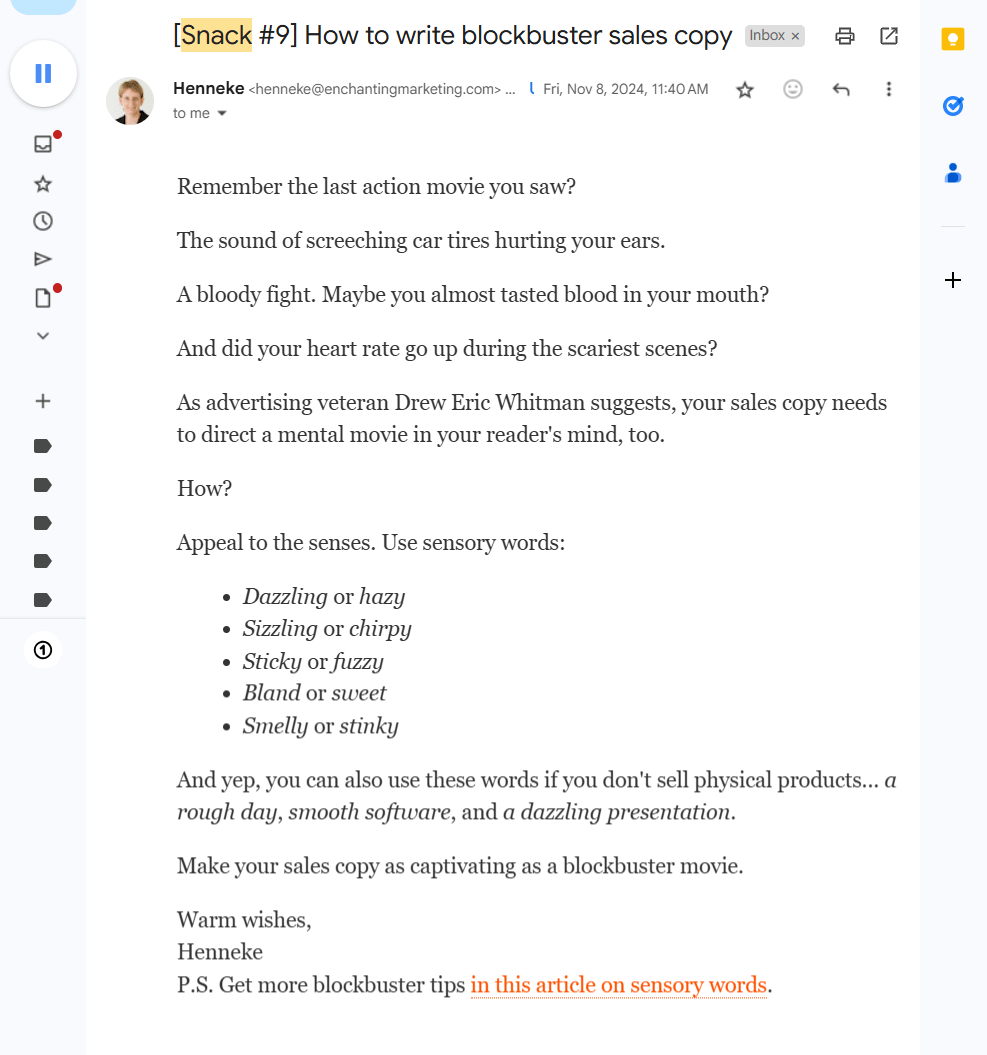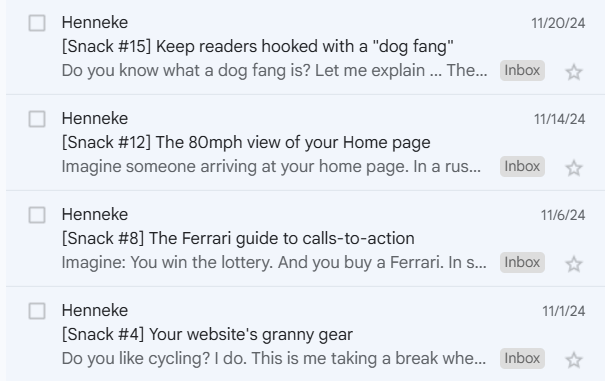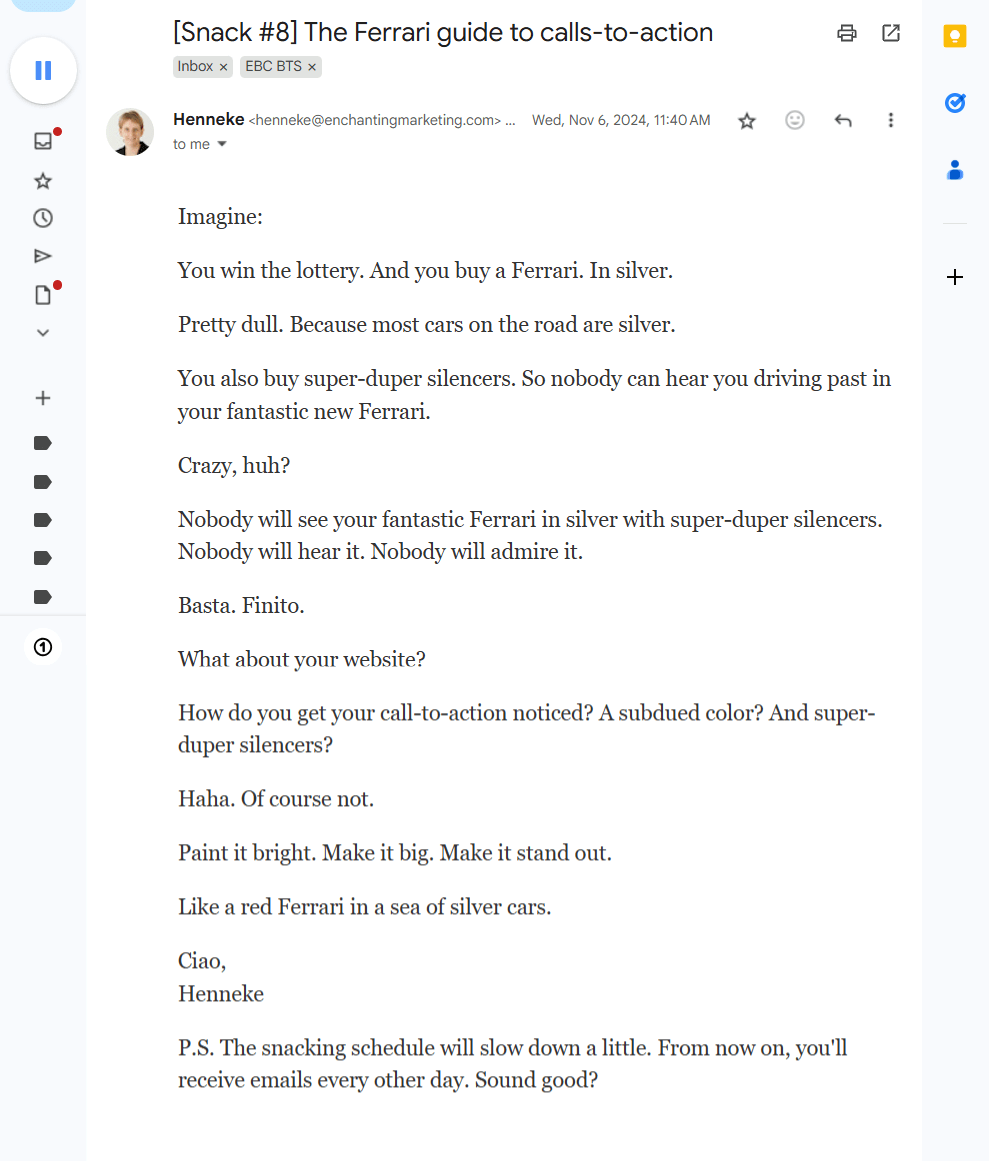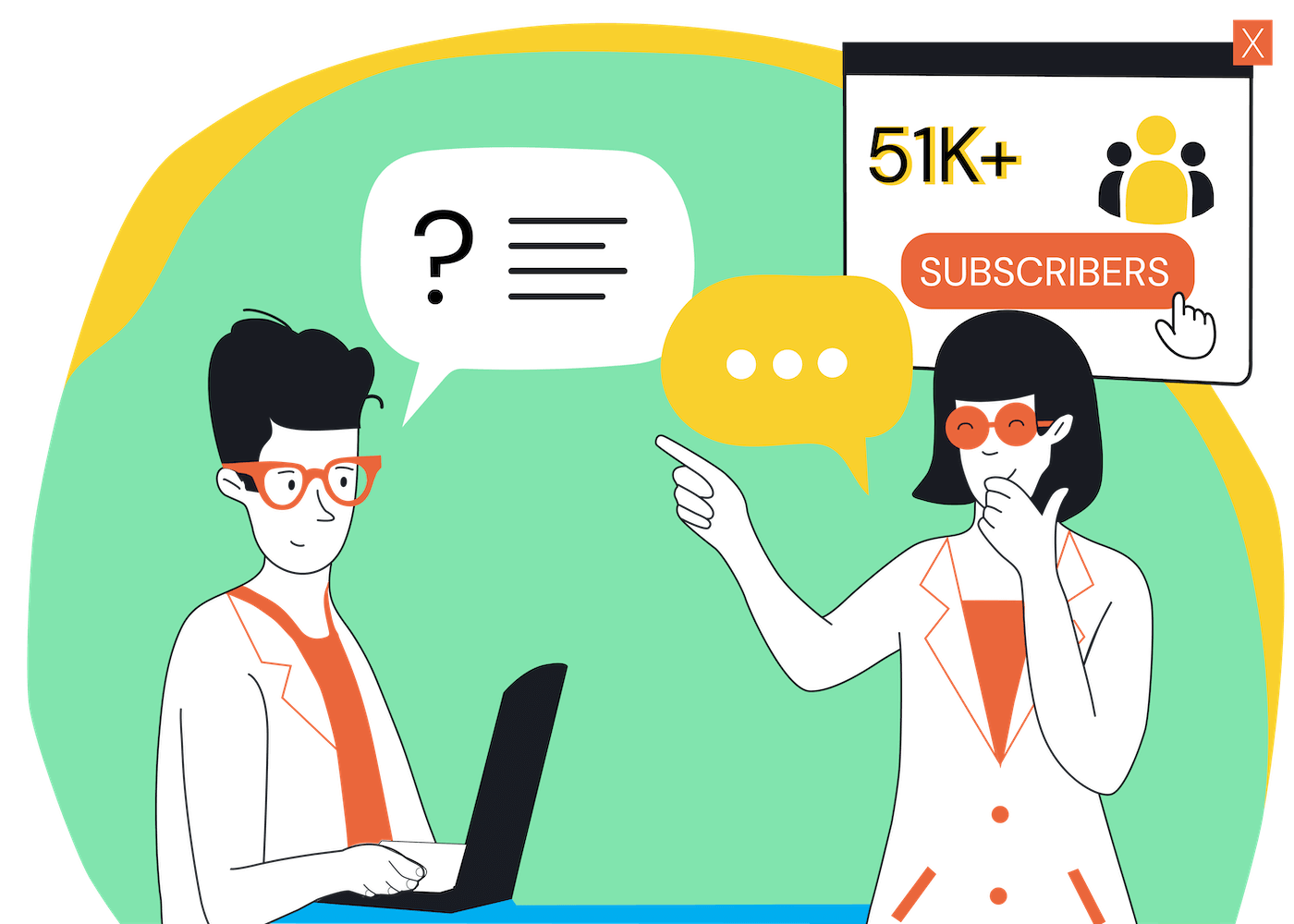EmailTooltester is supported by readers like yourself. We may earn a commission when you purchase through our links. Of course, this won't increase the cost for you.
Back in 2014, when most businesses were flooding inboxes with PDF freebies, Henneke Duistermaat launched something different – a free email-based course.
It started as her best short posts packaged into a free ebook. Then, evolved into a 16-part email sequence offered as the Snackable Writing Course.
Over a decade later, more than 51,000 people have subscribed to learn how to write clear, persuasive content. However, despite its success, Henneke is revamping the course to align with her current business goals and better meet her audience's needs.
In this behind-the-scenes breakdown of The 16-Part Snackable Writing Course, you’ll learn:
- What made it so effective for years
- Why and how it is being revamped
- Strategies you can apply to your email course
Let’s dive in.
Meet the Creator – Henneke Duistermaat
The founder of Enchanting Marketing, Henneke Duistermaat is a copywriting coach known for her distinct voice, hand-drawn illustrations, and bite-sized approach to teaching persuasive writing.
She has been featured everywhere from Copyblogger and HubSpot to Forbes and Inc.com. And she was named one of Search Engine Journal’s “50 Incredible Women in Marketing to Follow,” and AWeber’s “11 Digital Marketers to Watch.”
In the last decade, her 16-Part Snackable Writing Course has become a go-to for thousands of business writers who want to sharpen their skills and write with more clarity, personality, and persuasion.
How the Snackable Writing Course Started
Henneke didn’t set out to create an email course. She just didn’t have time to write full blog posts for her new subscribers while guest posting to build her email list.
“…So I started writing [and sending] short posts. Less than 200 words each. People seemed to love them, so at some stage I put my best emails into an ebook as an opt-in bonus.”
A few months in, she realized putting the tips into an ebook was, in her words, “daft.” Instead of giving people a PDF they’d likely never open, she turned those bite-sized lessons into an email sequence.
That sequence became The 16-Part Snackable Writing Course. And the structure was refreshingly simple:
- 16 snackable lessons, under 200 words each
- A link in the P.S. to explore more (added later)
- Daily emails for the first 8 days, then spaced out
It wasn’t just easier to consume. It became more popular than the ebook lead magnet and helped her build a solid relationship with subscribers.
What Made the Email Course Work (+ 5 Takeaways You Can Apply)
Most email courses overpromise and underdeliver. Often, they’re too long. Too info-heavy. Too focused on proving the creator’s expertise instead of delivering practical value.
The 16-Part Snackable Writing Course did the opposite. It delivered on its promise to help subscribers learn simple persuasion tricks, cure sentence bloat that irritates readers, and understand how to engage website visitors.
As a result, the emails in the sequence weren’t just collecting dust in inboxes. They were read, saved, and shared. Here are five things that made it work and takeaways you can apply to your own email course.
Snappy short emails
Just as the course name suggests, the emails were indeed snackable. They were short, and that didn't make them forgettable. Rather, it made them snappy, easy to digest, and actionable.
“Less than 200 words was the target I set for myself. It taught me to be concise — to share a lot of value (and personality) in short-form content.”
Henneke wrote for how people read: fast, distracted, and on the verge of clicking away. Her emails respected that reality and delivered value fast.

Email 9 of the Snackable Writing Course
Take this:
You don’t need long-form to deliver value. You need clarity, emotional pull, and just enough depth to drive action. Make sure every word in your email earns its place.
Curiosity-sparking subject lines
Yes, “how-to” subject lines work, and some were used in this email course. But there were also unexpected subject lines that intrigued and demanded attention.
My favorites:
- Your website’s granny gear
- The Ferrari guide to calls-to-action
- Keep readers hooked with a dog fang
You don’t scroll past these subject lines. They pull you in and make you click to find out what’s in the email. Read our guide for writing subject lines like these.

Four subject lines from the course emails
Take this:
If your subject lines sound like everyone else’s, they’ll blend into the inbox background. Don’t just summarize your email content: intrigue your readers. Use unusual language, metaphor, or tension to earn the open.
One clear point per email
Each email delivered one idea, insight, or tip. No rambling. No off-tangents. No info overload. And when there was more to explore, a CTA link added in the PS section led to an in-depth blog post (without forcing the click).
“Initially, the course didn’t have any links… I added those later. I was kind of surprised how many people click through because the emails aren’t link-optimised.”
The key point wasn’t held hostage behind a click, and the emails weren’t crammed with too much overwhelming information. The emails simply shared what was promised and offered more to those ready to dive deeper.

Email PS offering more resources
Take this:
Deliver the insight, tip, or whatever you promised in the email. Then use a link or CTA to share more relevant content. When your content delivers, people would naturally click to go deeper.
An expected frequency
Email courses work because you show up in the inbox daily with actionable value. However, a 16-part email sequence can feel like a lot. So, Henneke sent the first 8 lessons daily, then spaced the rest every 2-3 days.

Snapshot of frequency info in email
She explained this frequency in the welcome email to address the possible objection of not wanting to receive a daily email for 16 days. But, in the end, subscribers didn’t mind because they were receiving real value.
“I was afraid of people getting tired of me. But actually, I did occasionally receive emails from people saying they’d love to keep getting my emails daily, so maybe I could have kept the frequency daily.”
Take this:
Although the norm is a 5 to 7-day sequence, don’t be afraid to create a longer sequence for your email course. Just be intentional with pacing and upfront with what subscribers should expect.
Extra personal touches
The email course was more than just a sequence of writing lessons. It felt like a conversation. Henneke added personal extra touches that built a connection with subscribers, such as:
- Resources from her paid book gifted free inside the sequence
- Relatable stories and metaphors that brought the lessons to life
- Bonus practical guides and checklists to help subscribers take action

Relatable story email from the course
Take this:
The details matter. A timely question, small gift, or quick check-in can turn passive readers into engaged subscribers who reply, share, and remember you.
Why The Snackable Writing Course is Being Updated
For over a decade, the Snackable Writing Course did what it was meant to do. It delivered value. It engaged readers. It built trust. Subscribers still save the emails, and some still reply.
But success isn’t always a reason to keep things untouched. And while the course still works, Henneke’s business, The Enchanting Marketing, has evolved.
“A lot has changed, both in my business, what I’m writing about, and in the world of email marketing. So there’s a lot of opportunity for improvements.”
When Henneke created the course, she was selling coaching programs that were completely launch-driven. So there were no segmentations, no soft-sells, and no warm-up path to a paid offer.
Now, her business model has shifted. She sells self-paced writing courses (aka digital products) and wants the email course to support her sales funnel more intentionally.
That means making updates, like:
- Segmenting subscribers to send more relevant lessons
- Aligning each sequence to suitable paid offers
- Integrating her brand character, Henrietta
So yes, the Snackable Writing Course still delivers value. But this isn’t about fixing something broken. It’s about building a better bridge between what her subscribers need and what her business now offers.
What's Next for The Snackable Writing Course (+ 5 Ideas You Can “Steal”)
Henneke isn’t scrapping the snackable writing course. She’s refining it to create a better subscriber experience that reflects where her brand (and audience) is now. Here are some of her revamp plans and ideas you can “steal” for your own email course:
Create multiple snacks for different interests
Instead of sending everyone the same 16-part course, Henneke plans to create multiple snackable series, each tailored to a different pain point or goal.
“I want to segment at the start so I can send snacks depending on what people are most interested to learn. That would mean more than one snackable course, and people can get the most suitable series [for their needs].”
It’s a smart move because not all subscribers are on the same journey. So, with segmentation, she’ll ensure that each subscriber gets relevant lessons and is guided to the right offer.
Steal this:
Segment subscribers from the start to deliver content that fits their needs. You can do this by adding a quick 1-question filter on your opt-in form or in the welcome email.
Integrate brand character & illustrations
Besides the addition of self-paced courses, the Enchanting Marketing brand has evolved as well. Henrietta, the illustrated brand character, didn’t exist when the course was created. Today, she’s a fan favorite.
“She’s become a major part of my brand, and people tell me they love her, so she needs to be part of the course. I want to move from text-only to text + illustrations.”

Henrietta of The Enchanting Marketing
So, the revamped versions will include Henrietta and hand-drawn illustration explainers. This will align the email lessons with Henneke’s current visual identity and make the content more engaging and memorable.
Steal this:
Inject brand personality into your email course. Whether through voice, visuals, or story elements, build something that feels unmistakably you.
Update & upgrade the course content
Over the years, Henneke’s skills, techniques, and work have evolved. Plus, the copywriting industry (and digital world) has changed, too. So, the revamped course will reflect her updated frameworks, improved strategies, and deeper insights on persuasive writing.
Steal this:
Review your existing email course. What feels outdated? What no longer reflects your best work? What doesn’t meet your audience's needs? Update, upgrade, or replace as needed.
Add a soft sell to paid courses
The course, as it is now, has zero sales pitches. It simply delivers value and builds trust. But an email course isn’t only for engaging and building relationships with subscribers. It can (and should) be used to guide them towards buying.
“I want to use the series not just as a lead magnet but also as a way to sell my self-study courses.”
And with a valuable course like the Snackable Writing Course, she won’t need to hard-sell. A few touchpoints, such as soft CTAs, social proof, and strategic mentions, will position her paid offers as the obvious next step.
Steal this:
If your email course delivers on its promise, use it to warm subscribers up for your offer. Add a light call-to-action to a free consult, low-ticket offer, or waitlist.
Collect and include social proof
Although people love the course and often save the emails in a special folder, Henneke has never requested testimonials. For the revamped course, she plans to actively collect social proof. This will come in handy for promotions and increase credibility.
Steal this:
Invite readers to share feedback on your email course. And add it to your opt-in page or drop it into a mid-course email. Show your audience that your free course actually helps, and they’ll want in and stick with you.
How To Create An Email Course That Captures 51k+ Subscribers
You don’t need a fancy funnel, a content team, or a complex strategy to build an email course that works. What you need is a clear point of view, a human voice, and the guts to launch before you’re ready. If you’re planning to create or revamp your email course, here’s Henneke’s advice for you:
Write like you're talking to one person
This may sound obvious, but it’s one of the most ignored rules in email course creation (and email marketing generally). Too many people write as if they’re on a stage talking to a big group.
“…but email is a one-on-one conversation. Write for one person and they’ll feel like you’ve written for them personally, and your voice will sound more natural, more human. It’s the best way to connect more strongly.”
Whether you have 10 or 10,000 subscribers, your reader is always alone with your words. That intimacy is your advantage; use it. Leverage email personalization strategies to make every email feel like it was written specifically for them.
Try this:
Before writing your email lessons, picture one specific subscriber. What do they need? What are their struggles? What have they tried? Then, write for them. Not your “audience” or your “email list.” But a single subscriber.
Don’t wait for perfect. Just start
Henneke didn’t wait until she had all the pieces in place. She didn’t have products to sell. She hadn’t written all the blog posts the course would later link to. She didn’t even have a landing page when she first launched.
“My very first guest post went live before I had a landing page ready… In hindsight, it didn’t matter that much. It was most important to get going, not to get everything right.”
Yet, that imperfect start turned into a course that has captured 51k+ subscribers. Proof that an effective email course doesn’t come from “over-planning.” It comes from momentum.
Try this:
If you’re stuck in perfection paralysis, you’re delaying feedback. Launch it scrappy, learn as you go, and improve with data.
Have multiple promo strategies
Henneke captured subscribers without ads or a huge social media presence. Most of her traffic came from guest posts, SlideShare, and SEO. But looking back, she says that the biggest mistake she probably made was relying only on SEO.
“…it’s very risky to rely on just one source. Over the last few years, I’ve lost most of my organic search traffic, and it’s a challenge now to grow other sources of subscribers.”
What’s working now might not work anymore. So, you have to be prepared to adapt to the changing landscape. And that’s why she’s now building her LinkedIn presence to support her promotion efforts.
Try this:
Audit your traffic sources and visibility strategies. If they’ve shifted or slowed down, don’t wait for it to be a problem. Adapt and diversify your promotion plans before you’re forced to.
Final Thoughts: What Makes An Email Course Unforgettable
There’s a reason 51k+ subscribers have read, saved, and shared Henneke’s Snackable Writing Course.
It’s clear, valuable, and feels human. And that’s the real takeaway.
You don’t need to build the “perfect” email course. You need to build one that delivers on its promise, builds trust, and evolves with your business.
So, if you’re hesitating to create (or revamp) your email because you’re thinking, ”the market is saturated,” “what if it doesn’t work?” or “what if I break something that’s already working?”
Start by getting clear on what your subscribers need. Pause and ask yourself these 3 simple questions:
- What does my target audience keep asking for?
- What are they unsure of, stuck or struggling with?
- What’s the first step I can help them take to move forward?
Answer these, and you’ll create more than just a lead magnet. You’ll build a long-term asset that engages subscribers, builds trust, and invites action.
Need more guidance creating an effective email course? Read this step-by-step guide.
Our Methodology
This article has been written and researched following our EmailTooltester methodology.
Our Methodology

